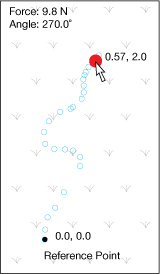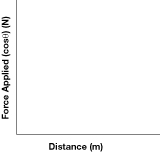Module 6—Work and Energy
 Lesson 3 Lab: Work-Potential Energy Theorem
Lesson 3 Lab: Work-Potential Energy Theorem
Problem
What is the relationship between the work done and the gain in mechanical energy for an object that is moved vertically in Earth’s gravitational field?
 Module 6: Lesson 3 Assignment
Module 6: Lesson 3 Assignment
Remember to submit the answers to LAB 1, LAB 2, LAB 3, LAB 4, and LAB 5 to your teacher as part of your Module 6: Lesson 3 Assignment.
Procedure and Observations
Open the Work-Energy Theorem simulation. Complete the following steps:
- Select the “Force Field” (
 ) at the top of the window to display the gravitational force vectors. (These are in the direction of the force you must do work against—in this case, gravity.)
) at the top of the window to display the gravitational force vectors. (These are in the direction of the force you must do work against—in this case, gravity.)
- Click and hold on the reference point and drag out a path until the y component (second value) of the position reads 2.0 as shown at the right.
- Once the path is drawn, click the “View Graph” tool (
 ). You may have to drag the bottom border of the window down to see the buttons. On the horizontal axis, select “Distance”; on the vertical axis, select “Applied Force * cos (Theta).”
). You may have to drag the bottom border of the window down to see the buttons. On the horizontal axis, select “Distance”; on the vertical axis, select “Applied Force * cos (Theta).”

LAB 1. Click “Fit graph” tool, and sketch the graph on your answer sheet.

LAB 2. Continue with the simulation by completing the following steps:
Enlarge the graph by dragging the right-hand side of the graph window to the right till you can see the last two buttons clearly. Determine the area (work) of the force-distance graph by pressing the “Integrate the Selected Graph” tool (![]() ) and dragging out the area under the graph from right to left. The area will be shown under the word “Output” at the top of the screen (Integral:). Record the area on your answer sheet.
) and dragging out the area under the graph from right to left. The area will be shown under the word “Output” at the top of the screen (Integral:). Record the area on your answer sheet.
LAB 3. Change the vertical axis of the graph to “Potential Energy,” and click the “Fit graph” tool button. Sketch the graph below. Click the “Options” button (![]() ). Select “Generate Table” to see the potential energy at the end of the motion. You can change the size of the columns in the data table by clicking on the title and dragging to the right. Record the potential energy at the end with the work done on the force-distance graph.
). Select “Generate Table” to see the potential energy at the end of the motion. You can change the size of the columns in the data table by clicking on the title and dragging to the right. Record the potential energy at the end with the work done on the force-distance graph.

work (area) = __________ potential energy at the end = ___________
LAB 4. According to your results in LAB 1, LAB 2, and LAB 3, does the work done equal the gain in potential energy when work is done against a conservative force such as gravity? In this context, what does the term conservative mean?
LAB 5. Reset the simulation, and close the graph window. Repeat the steps outlined at the beginning of the procedure using a different path that ends up at the same spot as the one completed in LAB 1 (y = 2.0). Note: You have to delete any old graphs before making new ones.


work (area) = ________ potential energy at the end = ________
Analysis
 Self-Check
Self-Check
SC 1. Based on your graphs above, if the work done equals the change in potential energy, why doesn’t the length of the path you take to move the object the same vertical height matter? (Hint: Recall that work is only done when the force and motion are in the same direction.)
 Self-Check Answers
Self-Check Answers
SC 1.
Since there are only vertical forces acting, no work is done in the horizontal direction. Therefore, the path length may be extended in the horizontal direction with no impact on the work done or the gain in potential energy.
 Module 6: Lesson 3 Assignment
Module 6: Lesson 3 Assignment
Remember to submit the answer to LAB 6 to your teacher as part of your Module 6: Lesson 3 Assignment.
Conclusion
There is a very simple relationship between the work that you do when you lift an object through a known distance and the change in that object's potential gravitational energy.
LAB 6. Work done is equal to the change in _______________.
 Read
Read
There is a very simple relationship between the work that you do when you lift an object through a known distance and the change in that object's potential gravitational energy. The gravitational force is known as a conservative force. (From Lesson 2, you may remember that conservative force acts in an isolated system, such as gravity, where the total work done is independent of the path an object is moved through.) Path independence is a very important property of conservative forces. This means that when an object does work against a conservative force, the work done does not depend on the path taken. The work done depends only on the final change in position or the vertical displacement of the object (since the force applied is vertical when you lift an object).
For example, since you know that the gravitational force is conservative, you can easily calculate the work done in lifting an object from one position to another. You don't have to worry at all about the path that the object takes. As you showed earlier, the work done is equal to the change in potential energy.
This is written as
![]()
work-potential energy theorem: a statement that says the work done in a gravitational field is equal to the change in potential energy
work-energy theorem: a statement that says the work done on a closed system is equal to the sum of the changes in the potential and kinetic energies of the system
In the formula, Δh is the change in height. This is sometimes called the work-potential energy theorem.
If the object being worked on also gains kinetic energy, the work done is defined as
![]()
This is known as the work-energy theorem—the work done on a closed system is equal to the sum of the changes in the potential and kinetic energies of the system.
If a chairlift moves a skier vertically upwards in a frictionless environment, the work done by the chairlift will be equal to the potential energy gain of the skiers when they reach the top of the mountain. However, the chairlift is not a closed system. In other words, energy may leave in the form of heat and sound generated by friction forces. Such forces are called non-conservative forces. The force of friction, for example, will act along the entire path of the chairlift from top to bottom.